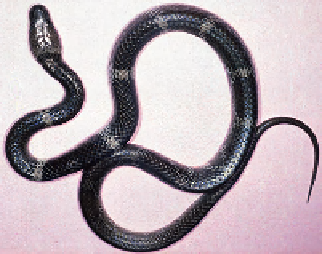Biology Reference
In-Depth Information
(A)
(B)
Plate 4.60
(A and B) Indian wolf snake or ular tana (
Lycodon aulicus
).
There are
approximately 29 species of
Lycodon
that occur in North and West Asia, Southeast Asia, and the
Indian subcontinent. One species, the northern wolf snake (
Lycodon striatus
), is also found in the
Middle East. These colubrine snakes are semiarboreal, nocturnal, and have dentition (enlarged
anterior and posterior maxillary teeth that lack grooves) that may be specialized for their
preferred prey: skinks and geckos. Bites by these snakes are typically medically insignificant.
(A)
Lycodon aulicus
, Sri Lanka.
(B)
Lycodon aulicus
, India, inflicting a medically insignificant bite.
Photos copyright to David A. Warrell.
those bitten had no evidence of envenoming (de Medeiros et al., 2010). Ten percent
had received a tourniquet before arriving at the hospital, and tourniquet use was sig-
nificantly associated with local edema. Secondary infection was reported in only 1%
of patients. These investigators concluded that
P. patagoniensis
bites may cause mild
local effects, and correct diagnosis is crucial in order to avoid the unnecessary use of
antivenom (de Medeiros et al., 2010).
In Cuiaba, Mato Grosso, Brazil, two-thirds of medically unimportant snakebites
are inflicted by
P. olfersii
(De Carvalho and Nogueira, 1998).
4.1.1.2 India
In a retrospective study conducted in three districts of West Bengal, Saha and Hati
(1998) described patterns of nonvenomous snakebites inflicted by
Cerberus rhynchops
(dog-faced water snake or bockadam; Plate 4.10A-C),
Lycodon aulicus
(common or
Indian wolf snake or ular tana;
Plate 4.60A and B
), and
Ptyas mucosus
(Indian or oriental
rat snake, dhaman; rope snake;
Plate 4.61
). They reported that 31 of 157 (19.7%) non-
venomous bites occurred in victims between 20 and 24 years old, and the lowest inci-
dence (8 of 157; 5.0%) was in victims between 5 and 9 years old. In comparison, bites
from venomous species such as
Daboia russelii
(Western Russell's viper, or in Sinhala,
“tit polông
-
”;
Plate 4.62
),
Naja naja
(Indian cobra, spectacled cobra, Asian cobra,
gokhura, nag, and many others;
Plate 4.63A and B
), and
Bungarus caeruleus
(com-
mon, Indian or blue krait, kalaz, domna chitti, and many others;
Plate 4.64
) were most
common in victims between 30 and 34 years old (15 of 88; 17%) and least frequent (1
of 88; 1.1%) in victims 0 to 4 years old (Saha and Hati, 1998). Although the specific



